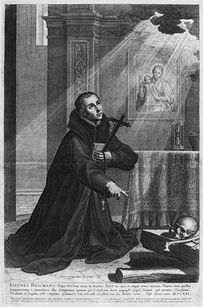
John Berchmans was born March 13, 1599, in the city of Diest situated in what is now the Belgian province of Flemish Brabant. The son of a shoemaker, his parents were John Charles and Elizabeth Berchmans. He was the oldest of five children. At his baptism, he was named John in honor of St. John the Baptist. He grew up in an atmosphere of political turmoil caused by a religious war between the Catholic and Protestant sections of the Netherlands. When he was nine years old his mother was stricken with a long and serious illness. John would pass several hours each day by her bedside. He studied at the Gymnasium at Diest and worked as a servant in the household of Canon John Froymont at Malines in order to continue his studies. John also made pilgrimages to the sanctuary of Scherpenheuvel, a few miles from Diest.
In 1615, the Jesuits opened a college at Malines (Mechelen), and St. John Berchmans was one of the first to enter. As soon as he entered the Jesuit college at Mechelen, he was enrolled in the Sodality of the Blessed Virgin. When Berchmans wrote his parents that he wished to join the Society of Jesus, his father hurred to Mechelin to dissuade him. He was sent to the Franciscan convent in Mechelin, where a friar, a relative of John's, attempted to convince him to change his mind. As a last resort his father told him that he would cut off all financial support.
Nevertheless, on September 24, 1616, John Berchmans entered the Jesuit novitiate. He was affable, kind, and endowed with an outgoing personality that endeared him to everyone. In 1618, he was sent to Rome to study philosophy and was an exceptional student. He requested after ordination to become a chaplain in the army, hoping to be martyred on the battlefield.
On September 25, 1618 he made his first vows. Berchmans was sent to Antwerp to begin the study of philosophy. Remaining there only a few weeks, he set out for Rome, where he was to continue the same study. After journeying three hundred leagues on foot, carrying his belongings on his back, he arrived at the Roman College, where he studied for two years. He passed on to the third year class in philosophy in the year 1621.
In early August of that same year, John Berchmans was selected by the prefect of studies to take part in a philosophical discussion at the Greek College, which at that time was under the charge of the Dominicans. John opened the discussion with great clarity and profoundness, but on returning to his own college he was seized with the "Roman fever".[2] Inflammation of the lungs set in and his strength rapidly gave way. He succumbed to dysentery and fever on the 13th of August, not yet twenty-three years of age. When he died, a large crowd gathered for several days to see him before his burial in Sant'Ignazio, and to invoke his intercession. The same year, Phillip, Duke of Aarschot, had a petition presented to Pope Gregory XV to gather information with a view to the beatification of John Berchmans.
At the time of the Saint’s death at Rome in 1621, his heart was returned to his beloved province in Belgium, and it is kept in a silver reliquary on a side altar in the church at Louvain. John Berchmans was declared Blessed in 1865, and was canonized in 1888. His statues represent him with hands clasped, holding his crucifix, his book of rules, and his rosary.
The miracle that led to his canonization happened at the Academy of the Sacred Heart, Grand Coteau. In 1866, just two years after the Civil War, he appeared to novice Mary Wilson. Her health was poor, but it was thought that the gentler climate of south Louisiana could be a remedy, however her health continued to decline. She could only take in liquids for about 40 days. “Being unable to speak, I said in my heart: “Lord, Thou Who seest how I suffer, if it be for your honor and glory and the salvation of my soul, I ask through the intercession of Blessed Berchmans a little relief and health. Otherwise give me patience to the end.” She went on to describe how John Berchmans then appeared to her, and she was immediately healed. When the Academy opened a boys division in 2006, it was named St. John Berchmans School. It is the only shrine at the exact location of a confirmed miracle in the United States.





